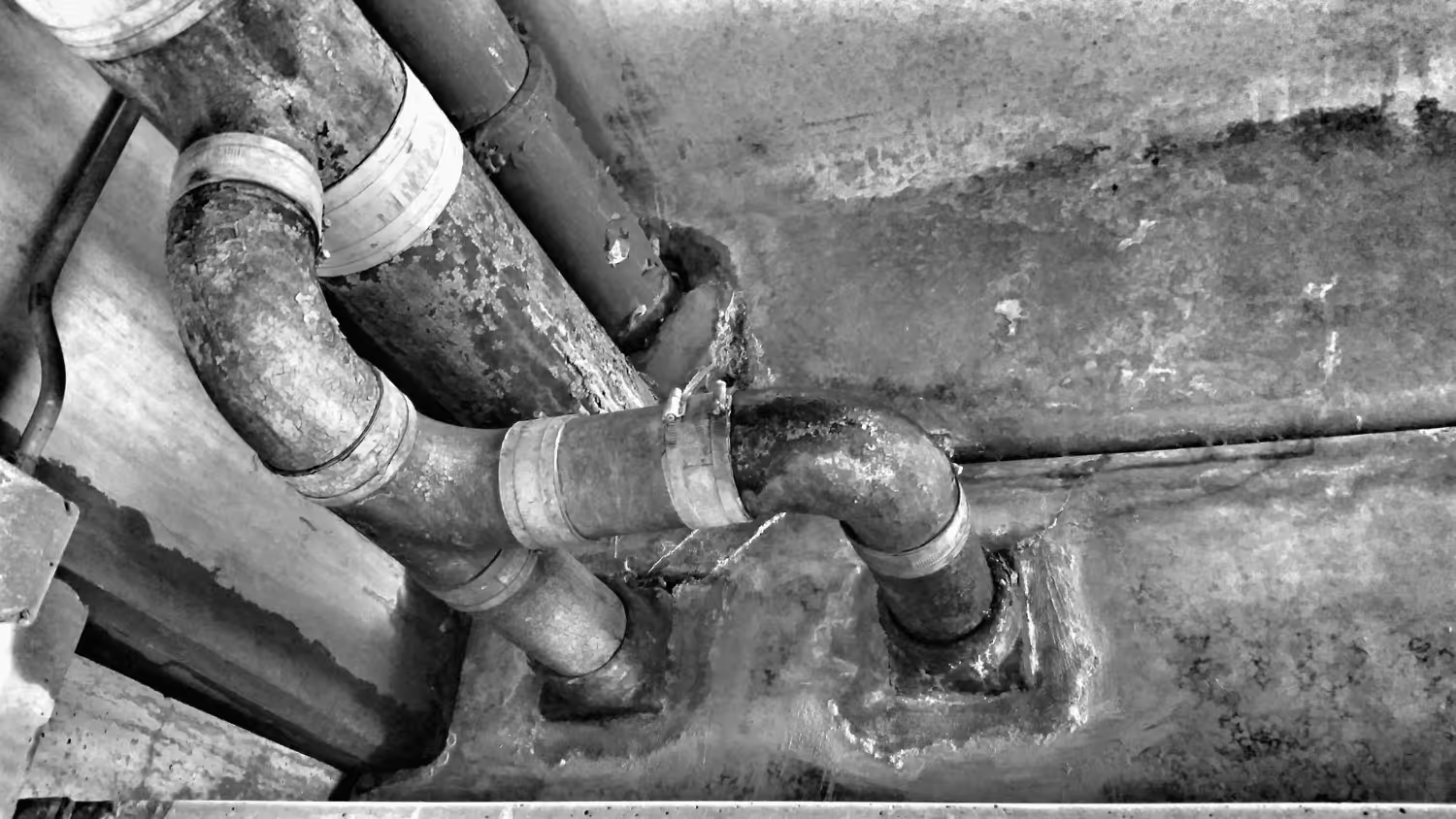


FREE Water Heater
With every whole house repipe purchase. Free brand-new water heater or credit towards a tankless water heater.
.svg)
.svg)
.svg)
.svg)



With every whole house repipe purchase. Free brand-new water heater or credit towards a tankless water heater.
.svg)
.svg)
.svg)
.svg)

A damaged sewer line can cause raw sewage backups, property damage, and health hazards that require immediate professional attention. The good news is that modern sewer line repairs methods offer effective solutions, from simple cleaning to complete pipe replacement.
Your home's sewer line carries wastewater away from toilets, sinks, and showers to keep your property clean and safe. When this underground system breaks down, it can create serious problems that go far beyond bad smells or slow drains.
The Florida DEP notes that frequent sanitary sewer overflows can indicate that the system requires repairs, upgrades, or expanded capacity to prevent future incidents. Understanding the warning signs and repair options helps you act quickly before small problems become expensive emergencies.
In this article, we'll walk you through everything you need to know about identifying sewer line damage, understanding what causes these problems, and exploring your repair options. You'll also learn about costs, insurance coverage, and simple steps to prevent future issues with your sewer system.
Here’s what you’ll find below:
By the end, you'll know how to recognize signs of a broken sewer line, understand the main causes of sewer line damage, and discover the repair options available for your home.
Recognizing sewer line problems early can save thousands in repair costs. Key warning signs include persistent odors, slow drains, and sewage backups that differ from typical drain clogs.
Foul odors are often the first sign we notice. A sewage smell in our yard, basement, or around our home means waste is escaping from the sewer line.
Slow drainage throughout multiple fixtures signals trouble. When sinks, tubs, and toilets all drain slowly at once, the main sewer line likely has damage.
We should watch for gurgling sounds from drains and toilets. These noises happen when air bubbles move through damaged pipes.
Soggy spots in our yard indicate underground leaks. The grass may grow greener in these areas due to sewage acting as fertilizer.
Pest problems often increase with sewer line breaks. Rats, insects, and other pests enter through cracks in damaged pipes.
Foundation issues can develop from sewer leaks. We might see cracks in walls or uneven floors as soil shifts around leaking pipes.
Higher water bills without increased usage suggest hidden leaks in our sewer system.
Understanding these differences helps us respond correctly to plumbing problems.
Clogged Drain
Sewer Backup
Affects one fixture
Affects multiple fixtures
Clear water backs up
Sewage backs up
Quick fix with plunging
Requires professional help
No outdoor signs
May cause yard flooding
Clogged drains typically impact just one sink or toilet. We can often fix these with a plunger or drain snake.
Sewer backups affect our entire home's drainage system. Water backs up in floor drains, toilets, and lowest fixtures first.
The type of backup tells us which problem we face. Clean water suggests a simple clog, while sewage indicates main line damage.
Location matters too. Multiple fixtures backing up simultaneously points to sewer line trouble rather than individual drain clogs.
We should contact plumbers immediately when multiple drains back up at once. This situation requires professional equipment and expertise.
Sewage odors around our property need immediate attention. These smells indicate health hazards that professionals must address quickly.
Recurring backups after we've tried basic fixes suggest deeper problems. Professional camera inspections can locate exact damage points.
We need experts when tree roots may be involved. Large trees near sewer lines often cause pipe damage that requires specialized removal techniques.
Foundation settling or yard flooding combined with drainage issues requires professional assessment. These problems can worsen rapidly without proper intervention.
Age factors matter too. Homes over 25 years old with original sewer lines benefit from preventive professional inspections.
Sewer line damage happens for three main reasons: pipes getting old and wearing out, tree roots growing into pipes, and bad habits that hurt the sewer system. Each cause needs different ways to fix and prevent problems.
The EPA reports that over 70% of sanitary sewer overflows (SSOs) are caused by structural failures like line breaks or blockages—and among blockages, the most common causes are oil and grease buildup, followed by tree root intrusion.
Old sewer pipes break down over time and cause serious problems. Most homes built before 1980 have clay or cast iron pipes that crack and crumble as they age.
Clay pipes last about 50 to 60 years before they start falling apart. These pipes crack when the ground shifts or freezes. Water seeps through the cracks and makes the damage worse.
Cast iron pipes rust from the inside out. They typically last 75 to 100 years but can fail sooner in areas with acidic soil. The rust eats through the metal and creates holes.
Common pipe materials and their lifespans:
Newer plastic pipes like PVC last much longer than old materials. They don't rust or crack as easily. However, even plastic pipes can break if the ground moves or heavy objects crush them.
Tree roots cause more sewer line damage than any other factor. Roots grow toward sewer pipes because they need water and nutrients that leak from small cracks.
Large trees like willows, oaks, and maples have roots that spread 50 feet or more from the trunk. These roots can break through concrete and crush metal pipes. Once inside, they grow thick mats that block water flow.
Ground movement also damages sewer lines. Earthquakes, settling soil, and freeze-thaw cycles crack pipes and break joints apart.
Environmental factors that damage sewers:
We see the most root damage in spring and fall when trees actively grow new roots. Older neighborhoods with big trees have more root problems than newer areas.
Many sewer problems start with things we flush or pour down drains. Grease, hair, and foreign objects create clogs that put pressure on pipes.
Cooking grease hardens inside pipes and catches other debris. Even small amounts build up over time. We should never pour grease down kitchen drains.
Flushing the wrong items damages pipes and creates blockages. Only human waste and toilet paper should go down toilets.
Items that damage sewer lines:
Chemical drain cleaners eat through pipe walls over time. The strong acids and bases weaken metal and plastic pipes. Using a plunger or drain snake works better and safer.
Regular maintenance prevents most habit-related damage. We recommend professional drain cleaning every two years to remove buildup before it causes problems.
Sewer lines can be fixed using traditional methods that involve digging trenches or modern trenchless techniques that work underground. The choice between repair and replacement depends on the extent of damage and the condition of existing pipes.
Traditional repair involves digging trenches to access damaged pipes directly. This method works well for severely damaged sections or when pipes need complete replacement.
We use excavation equipment to dig down to the sewer line. Workers then remove the damaged pipe section and install new pipes. The trench gets backfilled once the repair is complete.
Common traditional repair techniques include:
This method allows complete visual inspection of the problem area. We can address multiple issues at once during excavation.
Traditional repairs take longer and cost more due to labor and restoration needs. Landscaping, driveways, and sidewalks often need rebuilding after the work is done.
Weather conditions can delay outdoor excavation work. The process typically takes 2-3 days for standard repairs.
Trenchless methods fix sewer lines without major digging. These techniques access pipes through small entry points or existing openings.
Pipe lining involves inserting a flexible liner coated with resin into the damaged pipe. The liner inflates and hardens to create a new pipe inside the old one.
Pipe bursting breaks apart the old pipe while pulling a new pipe through the same path. This method replaces the entire line without trenching.
We use specialized cameras to inspect the pipe before choosing the repair method. The equipment enters through cleanouts or small access holes.
Trenchless repairs preserve landscaping and pavement. The work finishes faster than traditional methods, often in one day.
These methods cost more upfront but save money on property restoration. They work best when existing pipes have good structural support around them.
The decision depends on the pipe's age, material, and damage extent. Minor issues like small cracks or joint problems usually need repair only.
Repair works for:
Replacement becomes necessary when:
We inspect the entire line to assess overall condition. A pipe with 30% or more damage typically needs replacement rather than repair.
Cost analysis helps determine the best approach. Multiple repairs over time often cost more than one replacement project.
Pipe material affects the decision too. Clay and cast iron pipes from decades ago may need replacement even with minor damage.
Sewer line repairs can cost thousands of dollars, and most standard homeowners insurance policies don't cover these expenses. Understanding your coverage options and getting accurate repair quotes helps you prepare for these unexpected costs.
Sewer line replacement costs vary widely based on several key factors. The total expense typically ranges from $3,000 to $25,000 for most homes.
Factors that affect cost:
The replacement method also impacts your total bill. Traditional dig-and-replace methods cost $50 to $250 per linear foot. Trenchless pipe lining runs $80 to $250 per foot but causes less property damage.
Most homeowners pay between $8,000 and $15,000 for a complete main sewer line replacement. Partial repairs cost significantly less, typically $1,500 to $4,000.
Labor makes up about 70% of the total cost. Materials account for the remaining 30%.
Standard homeowners insurance policies typically exclude sewer line coverage. Most insurers consider sewer problems a maintenance issue rather than sudden damage.
Limited coverage situations:
We can add a service line endorsement to our policy for additional protection. This coverage costs $20 to $75 per year and covers repairs to water, sewer, and utility lines on our property.
The endorsement typically covers damage from:
Coverage limits usually range from $10,000 to $25,000 per claim. Some policies include a deductible of $500 to $1,000.
Without this endorsement, we're responsible for all repair costs. The endorsement doesn't cover pre-existing problems or damage from poor maintenance.
Getting multiple quotes helps us understand the true scope and cost of our sewer line repairs. We should contact at least three licensed contractors for comparison.
What contractors should include:
Ask each contractor to explain their recommended solution. Some may suggest partial repairs while others recommend full replacement.
Questions to ask contractors:
Request written estimates within one week of the inspection. Accurate quotes require a camera inspection of the entire line, which costs $200 to $500.
Avoid contractors who quote over the phone or offer prices significantly below others. Quality sewer work requires proper materials and skilled labor.
Most sewer lines last 50-100 years with proper care, but regular maintenance and smart prevention habits can help you avoid expensive repairs. Simple steps like watching what goes down your drains and scheduling regular inspections make a big difference.
The material of your sewer line affects how long it will last. Clay pipes typically last 50-60 years before needing replacement. Cast iron pipes can last 75-100 years but may develop rust issues sooner.
PVC pipes are the most durable option. They can last over 100 years with minimal maintenance. These modern pipes resist tree roots and corrosion better than older materials.
Several factors can shorten your sewer line's life. Tree roots growing into pipes cause major damage. Heavy soil movement from construction or weather can crack pipes early.
Poor installation also reduces lifespan. Pipes installed at wrong angles or depths often fail sooner than expected.
We recommend having pipes older than 40 years inspected every 2-3 years. This helps catch problems before they become expensive emergencies.
Watch what goes down your drains. Never flush diapers, wipes, or feminine products. These items cause serious blockages even when labeled "flushable."
Grease and cooking oil should never go down kitchen drains. Let grease cool and throw it in the trash instead. Even small amounts build up over time.
Plant trees away from sewer lines. Keep new trees at least 10 feet from your main sewer line. Tree roots naturally grow toward water sources and can crack pipes.
Trim existing tree roots regularly if they're near your sewer line. This prevents them from growing into small cracks and making them bigger.
Install drain screens in all sinks and tubs. These catch hair and debris before they enter your pipes. Clean the screens weekly to keep them working well.
Use enzyme-based drain cleaners monthly instead of harsh chemicals. Enzymes break down buildup without damaging your pipes.
Professional inspections every 3-5 years catch small problems before they become major repairs. Camera inspections show the inside condition of your pipes without digging.
During inspections, we look for cracks, tree root intrusion, and buildup. Finding these issues early saves thousands in emergency repair costs.
Regular cleaning prevents backups. Professional drain cleaning removes buildup that causes slow drains and blockages. This service typically costs $200-400 but prevents much more expensive problems.
Annual maintenance includes checking all drain connections and testing water flow. We also inspect outdoor cleanouts for damage or leaks.
Keep maintenance records of all services and repairs. These records help identify patterns and show potential buyers that you've maintained the system properly.
Schedule inspections before problems start. Waiting until you have slow drains or bad smells means damage may already be happening.
Sewer line repairs require prompt action to prevent costly damage to your home. When we notice warning signs like slow drains or bad smells, we should contact professionals right away.
We must choose repair methods based on damage severity and our budget. Minor problems often need less invasive solutions like trenchless repairs.
Regular inspections help us catch problems early. Professional plumbers have the right tools and knowledge to fix sewer lines correctly.
We should research qualified contractors before hiring them. Getting multiple quotes helps us make informed decisions about repair costs and methods.
Proper maintenance extends the life of our sewer lines. This includes avoiding flushing inappropriate items and scheduling routine cleanings.
Understanding repair options empowers us to act quickly when problems arise. Whether we need minor repairs or full replacement, professional help ensures lasting solutions for our plumbing system.
Schedule a professional sewer line inspection or repair with Sunshine Service to protect your home from costly backups and long-term damage.